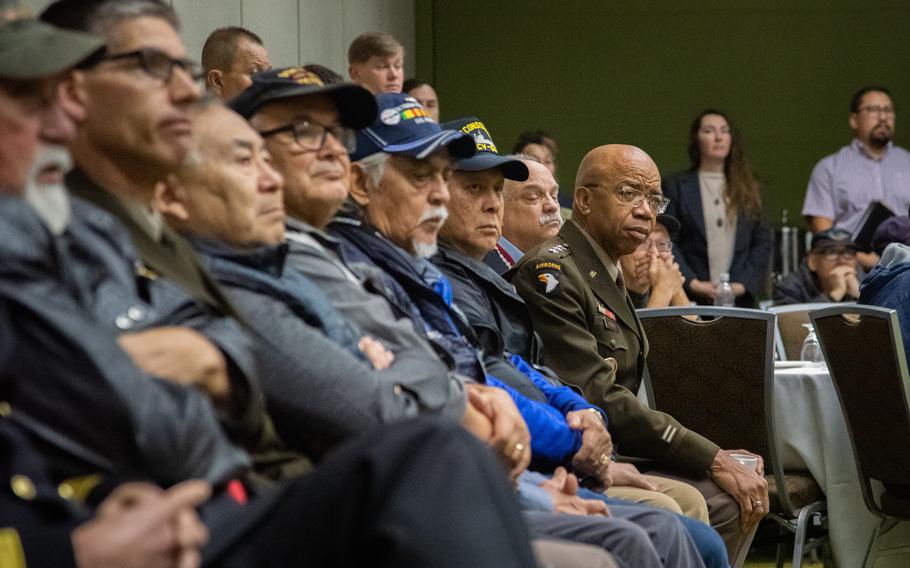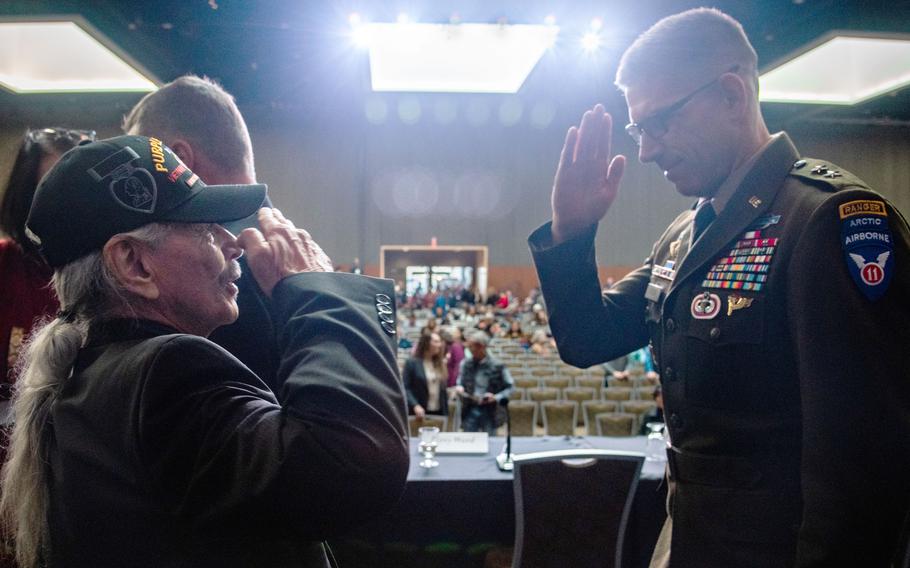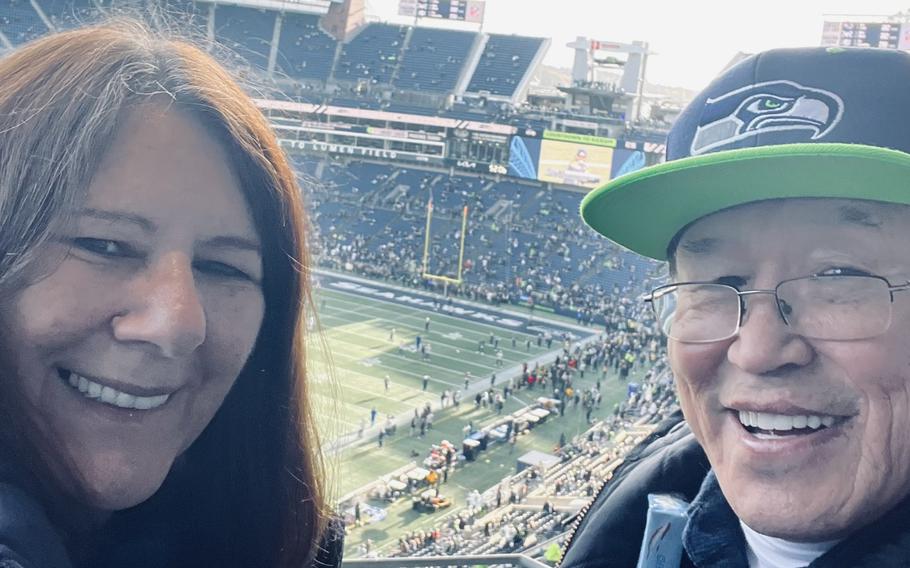
Army Lt. Gen. A. C. Roper, deputy commander of U.S. Northern Command, listens to Alaska Native veterans sharing their stories at a meeting with general officers and military veterans during the Alaska Federation of Natives Annual Convention in Anchorage, Alaska, on Oct. 21, 2023. (Don Hudson/U.S. Air Force )
WASHINGTON — At 18, Benno Cleveland traveled from his Arctic home in Alaska to fight in the swelter of Vietnam’s jungles, where he served two tours of duty before an infected leg injury ended his service in 1970 and nearly took his life.
“I spent my 19th and 20th birthdays in hospitals in Vietnam,” recalled Cleveland, who previously sustained shrapnel to his eye in a firefight.
At 73, he leads the Alaska Native Veterans Council, an advisory group to the Alaska Federation of Natives, the 49th state’s largest organization advocating for Alaska Natives and their interests.
“Ever since we became a territory our people have joined the military and served, even when we were not considered citizens,” said Cleveland, who also serves as president of the Alaska Native Veterans Association, representing a declining number of indigenous Vietnam veterans now in their 70s and 80s.
Cleveland has emerged as a critic and a champion of a unique federal land transfer program that seeks to give away up to 160-acre tracts of wilderness to Alaska Native Vietnam-era veterans or their heirs.
Nearly 30 million acres are available to Alaska Native veterans who were on active duty in the armed forces between Aug. 5, 1964, and Dec. 31, 1971. There is no other federal land transfer program like it, according to the U.S. Bureau of Land Management.

Benno Cleveland, founder Alaska Native Veterans Association, salutes Army Maj. Gen. Brian Eifler, deputy commander of Alaskan Command and commander of the 11th Airborne Division, during the Alaska Federation of Natives Annual Convention in Anchorage, Alaska, on Oct. 21, 2023. (Don Hudson/U.S. Air Force )
But the offer of free land comes with a caveat. Most tracts are largely inaccessible — with no road systems or airports — and often hundreds of miles from indigenous villages.
A total of 2,800 Alaska Natives served during the Vietnam War, with 1,971 identified and contacted in 2023 by the U.S. Bureau of Land Management about the land giveaway.
The program has had several go-arounds since the 1990s but failed to attract many takers because of occupancy and other restrictions, which recently were loosened.
The land bureau is making another push to locate and connect with Vietnam-era veterans in their later years of life.
But the experience of new allotment recipients such as Army veteran Bill Jarvinen shows how the promise of free land might fall short of goals.
Jarvinen, now in his 70s, is a retired trucker who worked on construction crews carving ice roads across the Alaska tundra for the big oil companies after serving in Vietnam.
The son of an Alaska Native mother from Nome, Jarvinen sought a vacation spot for his family when he and his wife, Sheri Nickel, applied for a land allotment.
The couple pored over an online map of available lands and chose a lakeside tract sight unseen near the Canadian border. Now he and Nickel are trying to figure out how to get there.
“A lot of the lands really are in the middle of nowhere,” Nickel said. “We tried to choose a site that looked more accessible.”

Vietnam veteran Bill Jarvinen and Sheri Nickel, his wife, at a Seattle Seahawks football game in 2022. (Provided by Bill Jarvinen and Sheri Nickel)
In 2022, Interior Secretary Deb Haaland, the daughter of a Vietnam veteran, expanded the Alaska land allotment program by opening 28 million acres for transfer under the John D. Dingell Jr. Conservation, Management and Recreation Act.
An earlier version of the federal program, initiated by former President Donald Trump’s administration, had less than 2 million acres available.
Fourteen certificates of allotment were issued for applications filed between December 2020 and March 2021. Another 315 applications are being processed under the expansion.
Federal officials visited Bethel, Alaska, in September for an informational meeting and plan to return in 2024 to help process applications.
Cleveland said he supports the recognition of military service by Alaska Natives through land allotments. But he added most sites are far from areas that indigenous people have occupied and used for generations.
He and other Alaska Native leaders are advocating for lands closer to where veterans have lived, hunted and fished, and raised families.
“We’ve been working on this for 30 years. They made more land available, but it is not the land we have used and know,” Cleveland said. “It’s a shame that we have to continue fighting, so our veterans and surviving family get the land where they grew up.”
Candy Grimes, Alaska Native allotment coordinator for the Bureau of Land Management, said federal lands closer to Alaska villages already were conveyed to Alaska Native corporations and the state of Alaska under the Alaska Native Claims Settlement Act of 1971.
Grimes and other federal officials said they appreciate concerns expressed by Cleveland and other Alaska Native leaders, but their role is to implement terms of the current program.
For new recipients such as Jarvinen, the idea of one day having a lakeside vacation home in Alaska’s pristine wilderness has him planning and dreaming about the future.
But the reality of getting to the property poses challenges and costs he has yet to work out. Jarvinen said he and his wife will have to travel 1,000 miles by plane from Seattle to Yakutat Airport, southeast of Anchorage.
From there, the couple will need to take a small plane 107 miles to Yakataga Airport, which has a turf landing field that bush pilots warn can be extremely soft after heavy rains and thaws.
In Yakataga, the couple will need all-terrain vehicles that Jarvinen described as “dune buggies” to reach the property. Judging from a map, he said the site appears to be 11 miles away.
“Bill has visions of putting a fishing house on the lake, which our grandsons will enjoy,” Nickel said.
Jarvinen added: “The lake doesn’t have a name yet, but I plan to take care of that. I will have to address that with the state.”